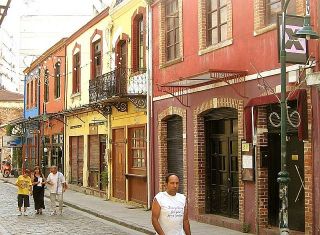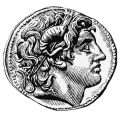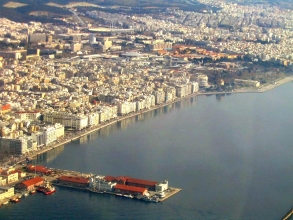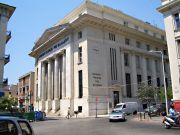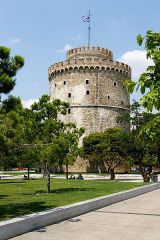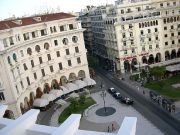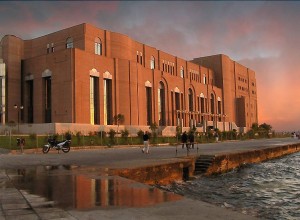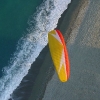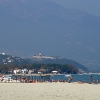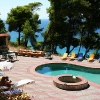Thessaloniki – co-Capital in the North
Thessaloniki (Greek: Θεσσαλονίκη, [θesaloˈniki]), Thessalonica, or Salonica is the second-largest city in Greece and the capital of the Greek region of Macedonia. Its honorific title is Συμπρωτεύουσα (Symprotévousa), literally “co-capital”, a reference to its historical status as the Συμβασιλεύουσα (Symvasilévousa) or “co-reigning” city of the Byzantine Empire, alongside Constantinople. According to the 2001 census, the municipality of Thessaloniki had a population of 363,987. The entire Thessaloniki Urban Area had a population of 763,468.
Thessaloniki is Greece’s second major economic, industrial, commercial and political centre, and a major transportation hub for the rest of southeastern Europe; its commercial port is also of great importance for Greece and its southeast European hinterland. The city hosts an annual International Trade Fair, the Thessaloniki International Film Festival, and the largest bi-annual meeting of the Greek diaspora.
Thessaloniki is home to numerous notable Byzantine monuments, including the Paleochristian and Byzantine monuments of Thessalonika, a UNESCO World Heritage Site, as well as several Ottoman and Sephardic Jewish structures.
Etymology
All variations for the city’s name derive from the original (and current) appellation in Greek: Θεσσαλονίκη, literally translating to “Thessaly-victory” and in origin the name of a princess, Thessalonike of Macedon, who was so named because she was born on the day of the Macedonian victory at the Battle of Crocus Field. The alternative name Salonica, formerly the common name used in some western European languages, is derived from a variant form Σαλονίκη (Saloníki) in popular Greek speech. The city’s name is also rendered Thessaloníki or Saloníki with a dark l typical of Macedonian Greek. Names in other languages prominent in the city’s history include سلانيك in Ottoman Turkish and Selânik in modern Turkish, Solun (Cyrillic: Солун) in the Slavic languages of the region by which it is still known in Macedonian, Serbian and Bulgarian to this day, Sãrunã in Aromanian, and Selanik/Salonika in Ladino. It is also known as ‘Thess’ by Anglophonic diaspora Greeks who returned to Greece and by the troops of the international forces stationed in the various ex-Yugoslav territories who visit the city for their breaks from duty.
Climate
Thessaloniki lies on the northern fringe of the Thermaic Gulf, on its western side. The city has a Mediterranean to Mid-European Temperate climate. Annual rainfalls are about 410–450 mm. Snowfalls are sporadic, but happen more or less every year.
The city lies in a transitional climatic zone, so its climate has displayed characteristics of continental and Mediterranean climate. Winters are relatively dry, with common morning frost. Snowfalls occur almost every year, but usually the snow does not stay for more than a few days. During the coldest winters, temperatures can drop to -10C°/14F (Record min. -14C°/7F).
Thessaloniki’s summers are hot with rather humid nights. Maximum temperatures usually rise above 30C°/86F, but rarely go over 40C°/104F (Record max. 44C). Rain is seldom in summer, and mainly falls during thunderstorms.
| Climate data for Thessaloniki | |||||||||||||
|---|---|---|---|---|---|---|---|---|---|---|---|---|---|
| Month | Jan | Feb | Mar | Apr | May | Jun | Jul | Aug | Sep | Oct | Nov | Dec | Year |
| Average high °C (°F) | 8.9 (48) | 10.6 (51) | 13.9 (57) | 18.3 (65) | 23.9 (75) | 28.9 (84) | 31.1 (88) | 30.6 (87) | 26.7 (80) | 21.1 (70) | 14.4 (58) | 10.6 (51) | 20 (68) |
| Average low °C (°F) | 1.1 (34) | 2.2 (36) | 5 (41) | 7.8 (46) | 12.2 (54) | 16.7 (62) | 18.9 (66) | 18.3 (65) | 15 (59) | 11.1 (52) | 6.7 (44) | 2.8 (37) | 10 (50) |
| Precipitation mm (inches) | 40 (1.57) | 30 (1.18) | 40 (1.57) | 30 (1.18) | 40 (1.57) | 30 (1.18) | 20 (0.79) | 20 (0.79) | 20 (0.79) | 40 (1.57) | 50 (1.97) | 50 (1.97) | 410 (16.14) |
| Source: Weatherbase 2009-02-01 | |||||||||||||
Cityscape
Architecture in Thessaloniki is the direct result of the city’s position at the centre of all historical developments in the Balkans. Aside from its commercial importance, Thessaloniki was also for many centuries, the military and administrative hub of the region, and beyond this the transportation link between Europe and the Levant (Syria, Lebanon, Jordan, and Palestine).
Merchants, traders and refugees from all over Europe settled in the city. The early Byzantine walls were moved to allow extensions to the east and west along the coast. The need for commercial and public buildings in this new era of prosperity led to the
construction of large edifices in the city centre. During this time, the city saw the building of banks, large hotels, theatres, warehouses, and factories. The city layout changed after 1870, when the seaside fortifications gave way to extensive piers, and many of the oldest walls of the city were demolished including those surrounding the White Tower.
The expansion of Eleftherias Square towards the sea completed the new commercial hub of the city. The western districts are considered as a working class section, near the factories and industrial activities; the middle and upper classes gradually moved from the city-centre to the eastern suburbs, leaving mainly businesses. In 1917, a devastating fire swept through the city and burned uncontrollably during 32 hours. It destroyed the city’s historic center and a large part of its architectural heritage.
A team of architects and urban planners including Thomas Mawson and Ernest Hebrard, a French architect, chose the Byzantine era as the basis for their (re)building designs. The new city plan included axes, diagonal streets and monumental squares, with a street grid that would channel traffic smoothly. The plan of 1917 included provisions for future population expansions and a street and road network that would be and still is sufficient today. It contained sites for public buildings, and provided for the restoration of Byzantine churches and Ottoman mosques. The whole Upper City,
near the fortifications, was declared a heritage site. The plan also included a site for the campus of a future University of Thessaloniki, which has never been fully realised, although today’s University campus incorporates some of Hebrard’s ideas.
An important element of the plan was to achieve a fine balance between contemporary urban planning and architectural ideas, and the city’s tradition and history. These plans have not been fully implemented, and the city still lacks of a full administrative district. Nevertheless, this aspect of the plan influenced a number of building and planning decisions throughout the 20th century, with inevitable adaptations to service the population explosion of the last 50 years.
Culture
The Opera of Thessaloniki was founded when the city was the European Capital of Culture in 1997. It is an independent section of the National Theatre of Northern Greece.
Thessaloniki is home of a number of festivals and events, including the Thessaloniki International Trade Fair which has been hosted at the Thessaloniki International Exhibition Centre. Over 300,000 visitors attended in 2007. The Thessaloniki International Film Festival has been established as one of the most important film festivals in Southeastern Europe, with a number of notable film makers such as Francis Ford Coppola, Faye Dunaway, Catherine Deneuve, Irene Papas and Fatih Akın taking part to it. The Documentary Festival, founded in 1999, has focused on documentaries that explore global social and cultural developments, with many of the films presented being candidates for FIPRESCI and Audience Awards. The Dimitria festival, founded in 1966 and named after the city’s patron saint of St. Demetrius, has focused on a wide range of events including music, theatre, dance, local happenings, and exhibitions. The “DMC DJ Championship” has been hosted at the International Trade Fair of Thessaloniki and has become a worldwide event for aspiring DJs and turntablists. The “International Festival of Photography” has taken place every February to mid-April. Exhibitions for the event are sited in museums, heritage landmarks, galleries, bookshops and cafés.
Sports
The main football stadiums in the city are the state-owned Kaftanzoglio Stadium, Toumba Stadium and Kleanthis Vikelides Stadium home fields of Iraklis, PAOK and Aris respectively, all of whom are founding members of the Greek league. Thessaloniki’s major indoor arenas are the state-owned Alexandreio Melathron, PAOK Sports Arena and the YMCA indoor hall. Other sporting clubs in the city include Apollon based in the eastern suburb of Kalamaria, Agrotikos Asteras based in Evosmos and YMCA. Thessaloniki has a rich sporting history with its teams winning the first ever panhellenic football, basketball, and water polo tournaments.
The city played a major role in the development of basketball in Greece. The local YMCA was the first to introduce the sport to the country while Iraklis won the first Greek championship. From 1979 to 1993 Aris and PAOK won between them 10 championships, 7 cups and a European title. In volleyball, Iraklis has emerged since 2000 as one of the most successful teams in Greece and Europe alike with several domestic and international successes. In October 2007, the first Southeastern European Games were organized in Thessaloniki.
Notable Thessalonians
Thessaloniki, throughout its history, has been home to a number of politicians, artists, craftsmen, sportsmen, clergy and singers among others. It is the birthplace of some Saints, as well as the Turkish military leader and statesman Mustafa Kemal Atatürk.
Source: Wikipedia


